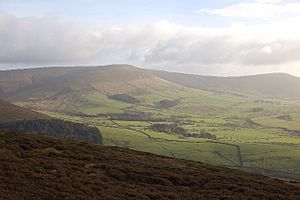Lordship of Bowland facts for kids
The Lordship of Bowland is a very old title connected to the Forest of Bowland in Lancashire, England. Think of it like a special historical ownership or right over a certain area. This lordship wasn't actively used between 1885 and 2008, and many people thought it had simply disappeared. However, it was brought back in 2008!
In 1885, a rich family called the Towneleys had their lands divided up after the last male family member passed away. These lands included the Forest of Bowland. Later, in 1938, the Crown (meaning the King or Queen, through the Duchy of Lancaster) bought about 6,000 acres (2,400 ha) of the forest, known as the Whitewell Estate. People generally thought that the Lordship of Bowland had also been transferred to the Crown at that time.
But it turned out that the sale of the Whitewell Estate didn't include the Lordship of Bowland itself. While it covered rights for minerals, hunting, and forestry, the actual title of the Lordship had been passed down to an old family trust that no longer existed. So, in 2008, Charles Towneley Strachey, 4th Baron O'Hagan, sold the Lordship in a private deal. The new 16th Lord of Bowland was later revealed to be a professor from Cambridge University. He was an expert in the history of Lancashire, its place names, and local ways of speaking, and he even had family ties to the Forest of Bowland.
The History of Bowland's Lordship
The history of the Bowland lordship can be traced back a very long time, possibly even to the year 638 AD! However, the modern form of the lordship really began after the Normans arrived in England.
Even though a person named Roger de Poitou is recorded as owning the lands of Bowland in the Domesday Book (a famous survey from 1086), what we know today as the Forest and Liberty of Bowland was created by William Rufus (King William II) sometime after 1087. A "Liberty" was a special area where the lord had certain rights and powers, almost like a mini-kingdom.
These lands were given to Roger de Poitou, who was a "vassal" (a loyal follower) of the King. This gift might have been a reward for Roger's help in defeating enemies in 1091-92, or it could have come from lands taken from another powerful person. These lands eventually became part of a larger area known as the Honor of Lancaster in the 1090s. By the late 1100s, these different land holdings in the Honor of Lancaster came together to form what we now know as Lancashire, which was officially recognized as a county in 1194.
The Forest and Liberty of Bowland, along with other nearby lands, became part of what was called the Honor of Clitheroe. The ownership of the Forest followed the same path as the Honor, eventually passing to the Earldom of Lancaster. After 1351, it was managed as part of the Duchy of Lancaster. From 1399 until the time of King Charles II, it was owned by the Crown. During this period, the lords of Bowland were even called "Lord Kings." The Forest stopped being part of the Honor in 1835.
The Lordship of Bowland covered a large area, almost 300 square miles (780 km2), right on the old borders of Lancashire and Yorkshire. It included a Royal Forest (a special hunting ground for the King) and a Liberty made up of ten smaller areas called manors. These manors were Slaidburn (which included Newton-in-Bowland, West Bradford, and Grindleton), Knowlmere, Waddington, Easington, Bashall, Mitton, Withgill (Crook), Leagram, Hammerton and Dunnow (Battersby). Another area called Harrop was part of the forest.
In 1661, the manors that were part of the old Honor of Clitheroe, including the Forest and Liberty of Bowland, were given by the Crown to General George Monck. This was part of the creation of the Dukedom of Albemarle. Monck was very important in bringing King Charles II back to the throne. The Lordship of Bowland then passed through several important families, including the Montagu, Buccleuch, and Towneley families, before being sold in 2008 to its current owner, the 16th Lord of Bowland. The main center or "seat" of the barony is Clitheroe Castle.


